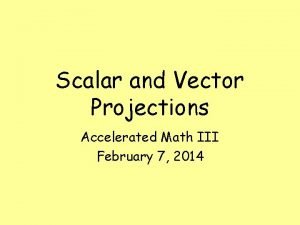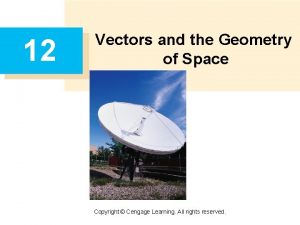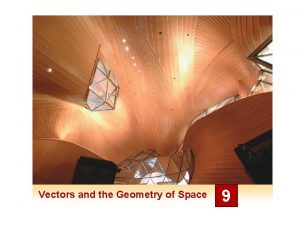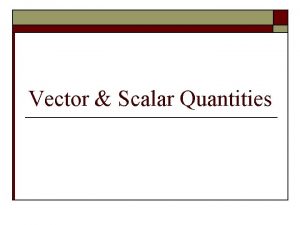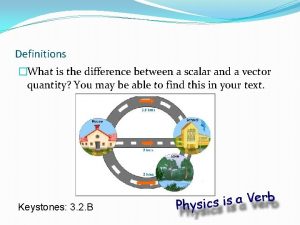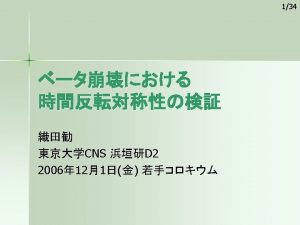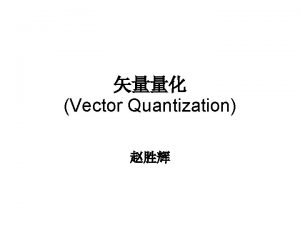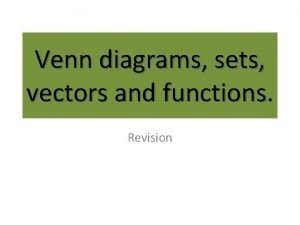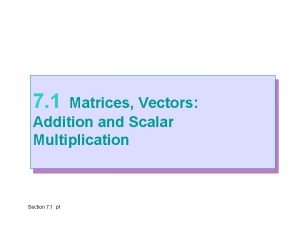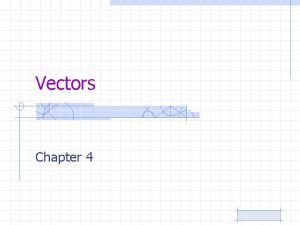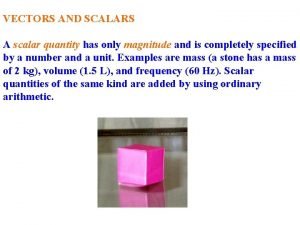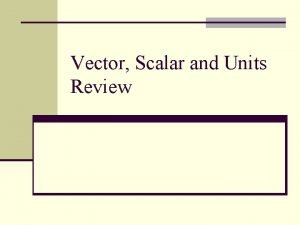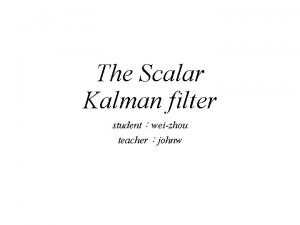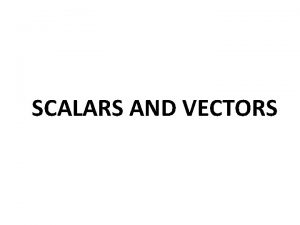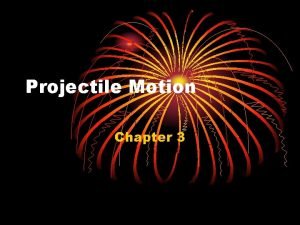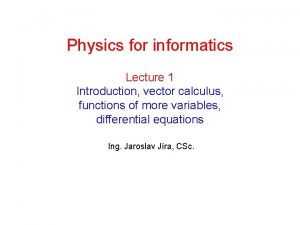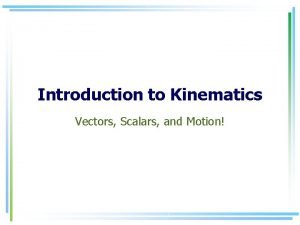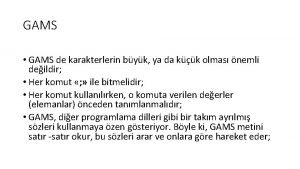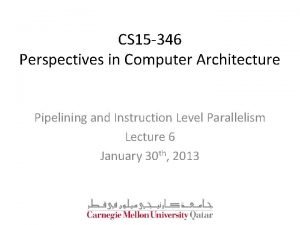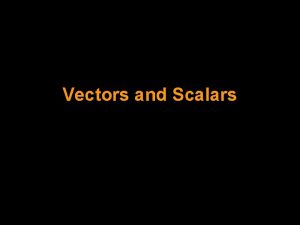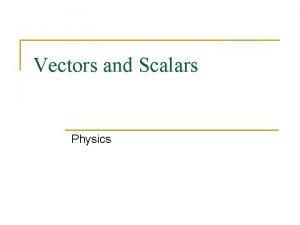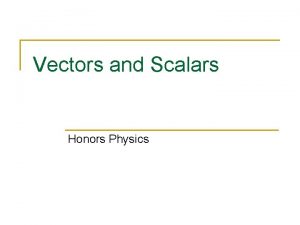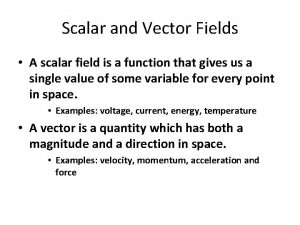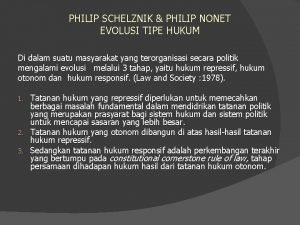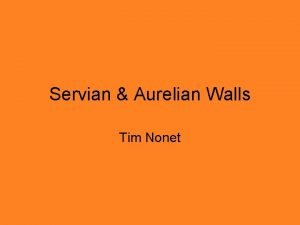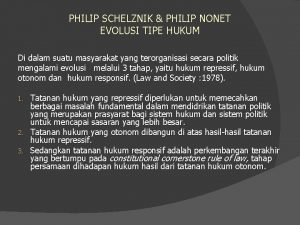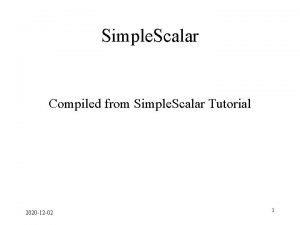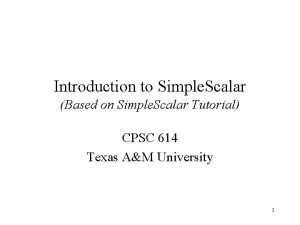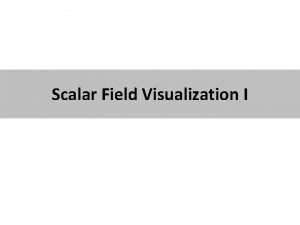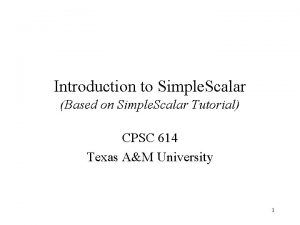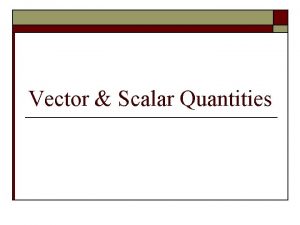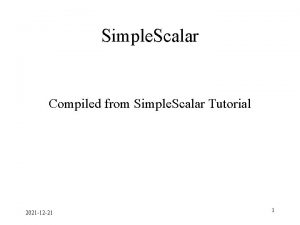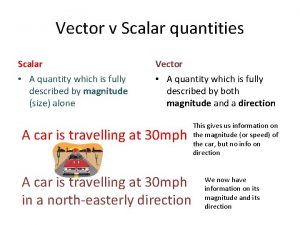The Light Scalar Nonet the sigma600 and the


































- Slides: 34

The Light Scalar Nonet, the sigma(600), and the EW Higgs Nils A. Törnqvist University of Helsinki Talk at Frascati January 19 -20 2006 Frascati. January 2006 Mixing Higgs N. A. Törnqvist

Tentative quark–antiquark mass spectrum for light mesons The states are classified according to their total spin J , relative angular momentum L, spin multiplicity 2 S +1 and radial excitation n. The vertical Each box represents a flavour nonet containing the isovector meson, the two strange isodoublets, and the two isoscalar states. • • Frascati. January 2006 Mixing Higgs , N. A. Törnqvist 2

Two recent reviews on light scalars Frascati. January 2006 Mixing Higgs N. A. Törnqvist 3

Why are the scalar mesons important? • The nature of the lightest scalar mesons has been controversial for over 30 years. Are they the quark-antiquark, 4 -quark states or meson-meson bound states, collective excitations, or … • Is the s(600) a Higgs boson of QCD? • Is there necessarily a glueball among the light scalars? • These are fundamental questions of great importance in QCD and particle physics. If we would understand the scalars we would probably understand nonperturbative QCD • The mesons with vacuum quantum numbers are known to be crucial for a full understanding of the symmetry breaking mechanisms in QCD, and • Presumably also for confinement. Frascati. January 2006 Mixing Higgs N. A. Törnqvist 4

What is the nature of the light scalars? In the review with Frank Close we suggested: Two nonets and a glueball provide a consistent description of data on scalar mesons below 1. 7 Ge. V. Above 1 Ge. V the states form a conventional quark-antiquark nonet mixed with the glueball of lattice QCD. Below 1 Ge. V the states also form a nonet, as implied by the attractive forces of QCD, but of a more complicated nature. Near the centre they are diquark-antidiquark in S-wave, a la Jaffe, and Maiani et al, with some quark-antiquark in Pwave, but further out they rearrange as 2 quark-antiquark systems and finally as meson–meson states. Frascati. January 2006 Mixing Higgs N. A. Törnqvist 5

Frascati. January 2006 Mixing Higgs N. A. Törnqvist 6

Recent s(600) pole determinations Frascati. January 2006 Mixing Higgs N. A. Törnqvist 7

BES collaboration: PL B 598 (2004) 149– 158 Finds the σ pole in J/ψ →ωπ+π− at (541± 39)−i(252± 42) Me. V Frascati. January 2006 Mixing Higgs N. A. Törnqvist 8

f(1020) p 0 p 0 g Study of the Decay f(1020) p 0 p 0 g with the KLOE Detector The KLOE Collaboration Phys. Lett. B 537 (2002) 21 -27 (ar. Xiv: hep-ex/0204013 Apr 2002) Sigma parameters from E 791 M s= Frascati. January 2006 Mixing Higgs N. A. Törnqvist 9

(a) The two pion invariant mass distribution in D+ to ppp decay (dominated by broad low-mass f 0(600)), and (b) the Dalitz plot (from E 791). Frascati. January 2006 Mixing Higgs N. A. Törnqvist 10

The invariant mass distribution in Ds to 3 p decay showing mainly f 0(980) and f 0(1370). and Dalitz plot (E 791). Frascati. January 2006 Mixing Higgs N. A. Törnqvist 11

The D+ to K- p+p+ Dalitz plot. A broad kappa is reported under the dominating K*(892) bands (E 791). Frascati. January 2006 Mixing Higgs N. A. Törnqvist 12

• Very recently • I. Caprini, G. Colangelo, H. Leutwyler, Hep-ph/05123604 from Roy equation fit get Frascati. January 2006 Mixing Higgs N. A. Törnqvist 13

Important things to notice in analysis of the very broad s(600) (and k(800)) • One should have an Adler zero as required by chiral symmetry near s=mp 2/2. This means spontaneous chiral symmetry breaking in the vacuum as in the (linear) sigma model. To fit data in detail one should furthermore have: • Right analyticity behaviour (dispersion relations) at thresholds • One should include all nearby thresholds (related by flavour symmetry) in a coupled channel model. • One should unitarize • Have (approximate) flavour symmetric couplings Frascati. January 2006 Mixing Higgs N. A. Törnqvist 14

The U 3 x. U 3 linear sigma model with three flavours If one fixes the 6 parameters using the well known pseudoscalar masses and decay constants one predicts: A low mass s(600) at 600 -650 Me. V with large (600 Me. V) pp width, An a 0 near 1030 Me. V, and a very broad 700 Me. V kappa near 1120 Me. V Frascati. January 2006 Mixing Higgs N. A. Törnqvist 15

Spontaneous symmetry breaking and the Mexican hat potential Cylindrical symmetry mp = Cylindrical symmetry ms mp = 0, ms > 0, proton mass>0 and constituent quark mass 300 Me. V Chosing a vacuum breaks the symmetry spontaneously Frascati. January 2006 Mixing Higgs N. A. Törnqvist 16

Tilt the potential by hand the pion gets mass mp > 0, ms > 0 But what tilts the potential? Another instability? Frascati. January 2006 Mixing Higgs N. A. Törnqvist 17

Two coupled instabilities breaking the symmetry If they are coupled, they can tilt each other spontaneously: Frascati. January 2006 Mixing Higgs N. A. Törnqvist 18

Another way to visualize an instability, An elastic vertical bar pushed by a force from above F<Fcrit F>Fcrit The cylindrical symmetry broken spontaneously Frascati. January 2006 Mixing Higgs N. A. Törnqvist 19

Now hang the Mexican hat on the elastic vertical bar. This illustrates two coupled unstable systems. Now there is still cylindrical symmetry for the whole system, which includes both hat and the near vertical bar. One has one massless and one massive near-Goldstone boson. Frascati. January 2006 Mixing Higgs N. A. Törnqvist 20

To see the anology with the Ls. M, write the Higgs doublet in a matrix form: NAT, PLB 619 (2005)145 and a custodial global SU(2)L x SU(2) R as in the Ls. M Frascati. January 2006 Mixing Higgs N. A. Törnqvist 21

Compare this with the Ls. M for p and s in matrix representation; Frascati. January 2006 Mixing Higgs N. A. Törnqvist 22

The Ls. M and the Higgs sector are very similar but with very different vacuum values. = Now add the two models with a small mixing term e This is like two-Higgs-doublet model, but much more down to earth. Frascati. January 2006 Mixing Higgs N. A. Törnqvist 23

The mixing term shifts the vacuum values a little and mixes the states And the pseudoscalar mass matrix becomes Frascati. January 2006 Mixing Higgs N. A. Törnqvist 24

Diagonalizing this matrix one gets a massive pion and a massless triplet Goldstone; 2 The pion gets a mass through the mixing mp = e 2[V/v +v/V]. Right pion mass if e = 2. 70 Me. V. The Goldstone triplet is swallowed by the W and Z in the usual way, but with small corrections from the scalars. Frascati. January 2006 Mixing Higgs N. A. Törnqvist 25

Quark loops should mix the scalars of strong and weak interactions and produce the mixing term e 2 proportional to quark mass? q higgs, WL q s, p Also isospin and other global symmetries schould be violated by similar graphs Frascati. January 2006 Mixing Higgs N. A. Törnqvist 26

Conclusions • We have one extra light scalar nonet of different nature, plus heavier conventional quark-antiquark states (and glueball). • It is important to have Adler zeroes, chiral and flavour symmetry, unitarity, right analyticity and coupled channels to understand the broad scalars (s, k) and the whole light nonet, s(600) k(800), f 0(980), a 0(980). • Unitarization can generate nonperturbative extra poles! • The light scalars can be understood with large [qq][qbar] and meson-meson components • By mixing the E-W Higgs sector and Ls. M the pion gets mass, and global symmetries broken? Further analyses needed! Frascati. January 2006 Mixing Higgs N. A. Törnqvist 27

Frascati. January 2006 Mixing Higgs N. A. Törnqvist 28

Frascati. January 2006 Mixing Higgs N. A. Törnqvist 29

Adler zero in linear sigma model Destructive interference between resonance and ”background” Example: resonance + constant contact and exchange terms cancel near s=0, Thus pp scattering is very weak near threshold, but grows rapidly as one approaches the resonance Frascati. January 2006 Mixing Higgs N. A. Törnqvist 30

Correct analytic behaviour from dispersion relation It is not correct to naively analytically continue the phase space factor r(s) below threshold one then gets a spurious anomalous threshold and a spurious pole at s=0. Frascati. January 2006 Mixing Higgs N. A. Törnqvist 31

Unitarize the basic terms. Example for contact term + resonance graphically: Frascati. January 2006 Mixing Higgs N. A. Törnqvist 32

K-matrix unitarization F. Q. Wu and B. S. Zou, Frascati. January 2006 Mixing Higgs hep-ph/0412276 N. A. Törnqvist 33

Frascati. January 2006 Mixing Higgs N. A. Törnqvist 34
 Light light light chapter 23
Light light light chapter 23 Into the light chapter 22
Into the light chapter 22 Light light light chapter 22
Light light light chapter 22 Put out that light
Put out that light Membrane bound organelles
Membrane bound organelles Or the bending of light and the bouncing off of light
Or the bending of light and the bouncing off of light What material blocks the light
What material blocks the light Vector in physics
Vector in physics All scalar and vector quantities
All scalar and vector quantities Vector quantity
Vector quantity Scalar and vector projections
Scalar and vector projections Scalar quantities have size or magnitude only
Scalar quantities have size or magnitude only Dot product
Dot product Vectors and the geometry of space
Vectors and the geometry of space Scalar characteristics
Scalar characteristics Scalar and vector quantity difference
Scalar and vector quantity difference Scalar vector tensor
Scalar vector tensor Scalar and vector quantization
Scalar and vector quantization Set notation venn diagrams
Set notation venn diagrams Scalar multiplication of matrix example
Scalar multiplication of matrix example Vector vs scalar
Vector vs scalar A scalar quantity has
A scalar quantity has Scalar units
Scalar units Scalar kalman filter
Scalar kalman filter Scalar pipeline
Scalar pipeline Scalar vector tensor
Scalar vector tensor Entropy is scalar or vector
Entropy is scalar or vector Is projectile motion a scalar or vector
Is projectile motion a scalar or vector Nabla operator
Nabla operator Angular displacement scalar or vector
Angular displacement scalar or vector Vector quantity
Vector quantity Symbolab surface area integral
Symbolab surface area integral Gams kodu
Gams kodu Distance is a scalar
Distance is a scalar Scalar pipeline in computer architecture
Scalar pipeline in computer architecture










